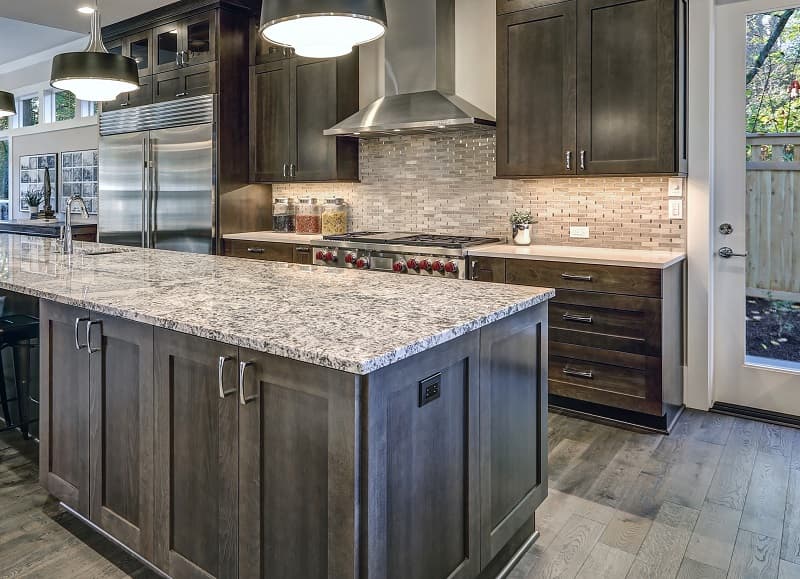How to Lay Rectangular Ceramic Tiles
By Editorial Team
Updated on November 7, 2023

Are you hoping to install tiles in your kitchen or bathroom? If choosing the tile pattern and size are initial questions on your mind, what about the technique used when laying tiles?
While the appearance of the tile is certainly of great importance, the method of laying tiles needs to be taken into consideration. Here’s a brief overview of the options available to you for this ceramic project.
6 rectangular ceramic tile laying techniques
1- Chevron

Standing out for its undeniable originality, the chevron installation still requires great care to be executed to perfection. What's more, it involves making several cuts, which requires investing more time to carry out the project. Moreover, as losing tiles and materials is more considerable, this will have an influence on the necessary budget.
Let's finish by mentioning that this method takes advantage of the diagonal line of the room, which has the benefit of visually enlarging the room. Therefore, this technique should be a priority for small bathrooms or kitchens.
2- Offset

Although the staggered installation follows a straight line, it nevertheless turns out different from what the name suggests. Essentially, this one follows a 2/3-1/3 ratio. As with a straight installation, it’s of the utmost importance that the spacing of this installation is the same from start to finish. More specifically, you should know that there are three types of spacing:
the second tile is placed after the first third of the first tile;
the second tile is laid after the first quarter of the tile laid first;
the second tile is laid so that it starts halfway from the first tile. This technique is particularly suitable for small tiles.
3- L-shaped

Photo: Ardosia Slate
Visually similar to the rafter installation, it still has several significant differences: the fact that it aligns perpendicular to the wall and requires fewer cuts to complete. As its effect reduces the length of a space, it’s a good option for narrow hallways.
4- Parquet

This method lays two rectangular tiles horizontally (one above the other), then two vertically and so on. Similar to the straight-line installation, this type of installation limits the number of cuts necessary to complete the project, making it an economic option.
Regarding its aesthetic qualities, it’s considered to be particularly effective in visually reducing the length of narrow passages such as corridors. Although classic, this type of layout adds a touch of originality to a room’s design. Finally, it’s relatively easy to install, which will delight many!
5- Herringbone

Photo: Mercury Mosaics
When it comes to originality, the herringbone pattern is one of a kind! It consists of tiles laid in a "V" shape, which gives the impression of several "V's" fitted into each other. Installation needs a certain amount of expertise, which ideally requires calling a professional if you have little experience carrying out this type of project.
6- Straight

Laying tiles in a linear fashion. Not surprisingly, this technique is particularly popular. Why is that? Quite simply because it’s the perfect choice for contemporary and modern decors and it limits the number of cuts required for this tile installation. The losses are small, which makes this option inexpensive.
Would you like more information about ceramics? We have some articles for you:
Get 3 renovation quotes for your tiling project
RenoQuotes.com can help you get quotes for your tile renovation project. If you submit your project to us, we’ll put you in contact with top-rated contractors. Fill in the form on the homepage (it only takes a few minutes), and you will get estimates from trusted professionals.
Dial 1-844 828-1588 to speak with one of our customer service representatives
Looking for something else?
Related articles
The latest industry news, interviews, technologies, and resources.

Editorial Team
•05 Dec 2025
Your bathroom is a room on its own, which is purely functional for most, yet somewhere many others will soak in a warm candlelit bath. Painting the surfaces around bathroom-specific items is a simple and cost-effective way to revamp the area and change the overall look. Now it’s up to you to choose the right paint to coat this humidity-prone area.

Editorial Team
•07 Nov 2023
Wall panels are a wonderful feature for the home, and they come in a variety of materials, shapes, styles and colours. Therefore, they can be used alongside almost any home decor, made to suit the needs of any homeowner. Panelling can cover an entire wall, or just half if you so choose. Installing wall panelling is a DIY project that can be easily accomplished with the right steps and the options are endless!

Cynthia Pigeon
•14 Jun 2024
Not only is cleaning your fireplace essential to its proper functionality, but it also contributes to its safe use.

Amanda Harvey
•07 Nov 2023
Is your home ready for a much-needed renovation? Do you feel like you're prepared to take on the job? Many homeowners feel as though everything has already been considered and arranged, but there are often aspects of home renovations that are overlooked and can lead to serious problems down the line.

Christine Simard
•07 Nov 2023
Have you decided to change your floor covering and your choice fell on ceramic? Regardless of the specific tile pattern that caught your attention, you will need to purchase grout.